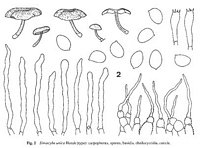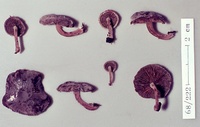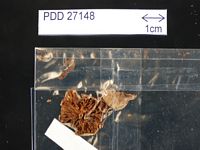|
 Simocybe unica Simocybe unica
BiostatusPresent in region - Indigenous. Endemic
Images (click to enlarge) | 
Caption: ZT68-222, Holotype
Owner: E. Horak: © Creative Commons Attribution-Noncommercial 3.0 New Zealand | 
Caption: Dried type specimen
Owner: Herb PDD |
Article: Horak, E. (1980). Fungi Agaricini Novazelandiae. X. Simocybe Karsten. New Zealand Journal of Botany 18(2): 189–196 (http://www.rsnz.org/publish/abstracts.php).
Description: Pileus -30 mm, hemispheric when young becoming convex or plane with subdepressed centre, margin incurved; olive-brown; conspicuously velutinous, pruinose or hoary, often with a silvery, metallic sheen, dry, covered with transparent guttation drops in young specimens, margin not striate, centre distinctly wrinkled to venose in mature carpophores, veil remnants absent. Lamellae crowded, densely intermixed, adnate to adnexed, becoming emarginate in fully expanded specimens; olive-grey or olive-brown when young turning brown to fuscous, edge albofimbriate. Stipe -25 x -2 mm, cylindric, equal, central or eccentric; concolorous with pileus, entirely pruinose, dry, veil remnants none, apical portion with guttation drops in fresh specimens, fistulose; single or cespitose, in groups. Context olive-brown. Odour and taste acidulous to spermatic-farinaceous. Chemical reactions on pileus:KOH - red-brown. Spore print brown. Spores 6-6.5 x 4-5 µm, ovate to subphaseoliform, sometimes pip-shaped, membrane smooth, brown, thin-walled, germ pore none. Basidia 20-30 x 6-7 µm, 4-spored. Cheilocystidia 40-80 x 3-6 µm, cylindric, apex conic or subclavate, membrane thin-walled in upper portion only, up to 1 µm diam. towards basal septum, hyaline to pale brown. Pleurocystidia absent. Caulocystidia like cheilocystidia. Cuticle a palisade of cylindric cells gradually tapering towards apex (25-70 x 2-6 µm), basal cells globose or ovoid, membrane not gelatinised, with brown (KOH) membranous or/and encrusting pigment. Clamp connections numerous.
Habitat: o n rotten wood and bark of Nothofagus (N. solandri (Hook.f.) Oerst. var. clifforlioides (Hook.f.) Poole). New Zealand,
Notes: The very peculiar structure of the pileal cuticle makes S. unica one of the most distinctive species of Simocybe.
In the field this species can be mistaken for S. pruinata Horak since both fungi occur not only in similar ecological habitats (rotten wood and bark of Nothofagus spp.) but also share color and the hoary-velutinous surface of stipe and pileus. However, microscopic characters readily distinguish the two agarics.
|